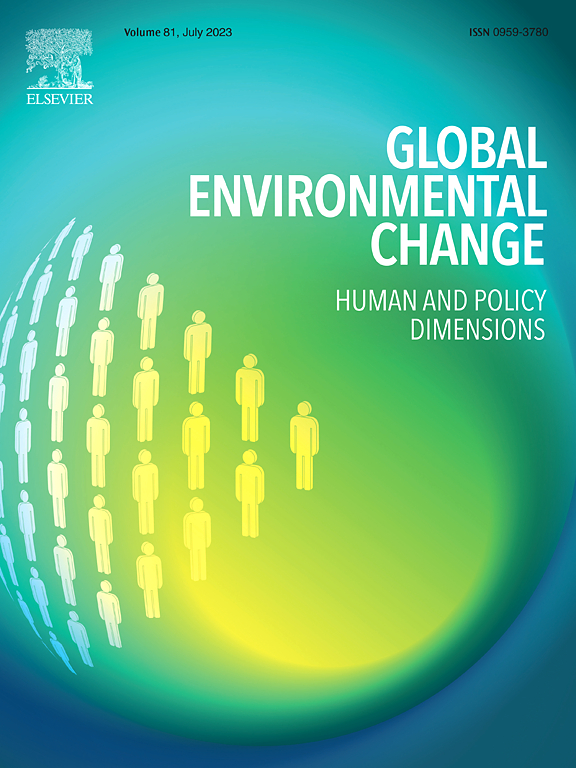畜牧业零毁林协议能保护哥伦比亚的森林和páramos吗?
IF 9.1
1区 环境科学与生态学
Q1 ENVIRONMENTAL SCIENCES
引用次数: 0
摘要
针对哥伦比亚牛肉和乳制品行业的零毁林协议(zda)可以遏制该国生物多样性丰富的热带森林和páramos的土地覆盖变化。提高对牛供应链结构和zda潜在影响领域的理解,可以帮助具有高风险供应链的目标公司,为实施提供信息,并为zda对森林和páramos保护目标的贡献设定现实的期望。我们为牛肉和乳制品行业提供了第一张基础设施地图,并将其与牛交易数据集联系起来,以划定每个屠宰场和乳制品的“供应区”或潜在购买区域。我们使用这些供应区来评估三种空间上明确的情景,以扩大参与zda的潜在影响。目前,ZDA签署国的供应区覆盖了10.4公顷森林,占哥伦比亚森林面积的23%,其中牛肉部门签署国的影响力很大。所有大公司的参与可以使zda覆盖面扩大近一倍,达到41%的森林,全面参与可以达到49%的森林。ZDA也将目标锁定在高山地区páramos,其中57%的未受保护的páramos位于签署方的供应区内。充分参与可以保护这一独特生态系统的96%。我们发现,间接的动物运动占供应链的80%,因此政策的实施将取决于监测和可追溯系统,而不仅仅是供应商直接向屠宰场或奶牛场销售。必须有更多的公司参与并有效实施zda,以实现这一保护潜力。本文章由计算机程序翻译,如有差异,请以英文原文为准。
Can zero deforestation agreements in the cattle sector protect Colombia’s forests and páramos?
Zero Deforestation Agreements (ZDAs) for the beef and dairy sectors in Colombia could curb land cover change in the country’s highly biodiverse tropical forests and páramos. Improved understanding of the structure of the cattle supply chain and the ZDAs’ potential area of influence can help target companies with high-risk supply chains, inform implementation, and set realistic expectations for the ZDAs contribution to conservation goals for forest and páramos. We provide the first map of infrastructure for the beef and dairy sectors and link this to a dataset of cattle transactions to delineate “supply zones” or potential buying areas for each slaughterhouse and dairy. We use these supply zones to assess three spatially explicit scenarios of the potential reach of the ZDAs with expanded participation. At present, ZDA signatories’ supply zones cover 10.4 Mha or 23% of Colombia’s forests, with a large area of influence associated with beef sector signatories. Participation of all major companies could nearly double the ZDAs reach to include 41% of forests, and full participation could reach 49% of forests. The dairy ZDA also targets high alpine páramos, and 57% of unprotected páramos are within signatories’ supply zones. Full participation could support the conservation of 96% of this unique ecosystem. We found that indirect animal movements make up 80% of the supply chain, so policy implementation will depend on monitoring and traceability systems that go beyond suppliers selling directly to slaughterhouses or dairies. More companies must participate and effectively implement the ZDAs to realize this conservation potential.
求助全文
通过发布文献求助,成功后即可免费获取论文全文。
去求助
来源期刊

Global Environmental Change
环境科学-环境科学
CiteScore
18.20
自引率
2.20%
发文量
146
审稿时长
12 months
期刊介绍:
Global Environmental Change is a prestigious international journal that publishes articles of high quality, both theoretically and empirically rigorous. The journal aims to contribute to the understanding of global environmental change from the perspectives of human and policy dimensions. Specifically, it considers global environmental change as the result of processes occurring at the local level, but with wide-ranging impacts on various spatial, temporal, and socio-political scales.
In terms of content, the journal seeks articles with a strong social science component. This includes research that examines the societal drivers and consequences of environmental change, as well as social and policy processes that aim to address these challenges. While the journal covers a broad range of topics, including biodiversity and ecosystem services, climate, coasts, food systems, land use and land cover, oceans, urban areas, and water resources, it also welcomes contributions that investigate the drivers, consequences, and management of other areas affected by environmental change.
Overall, Global Environmental Change encourages research that deepens our understanding of the complex interactions between human activities and the environment, with the goal of informing policy and decision-making.
 求助内容:
求助内容: 应助结果提醒方式:
应助结果提醒方式:


